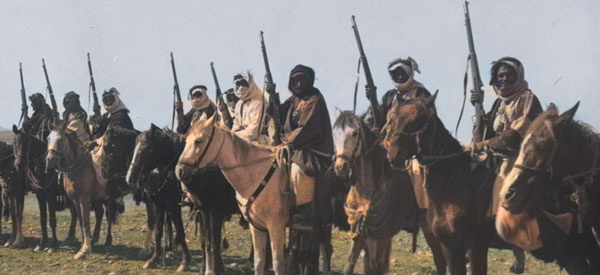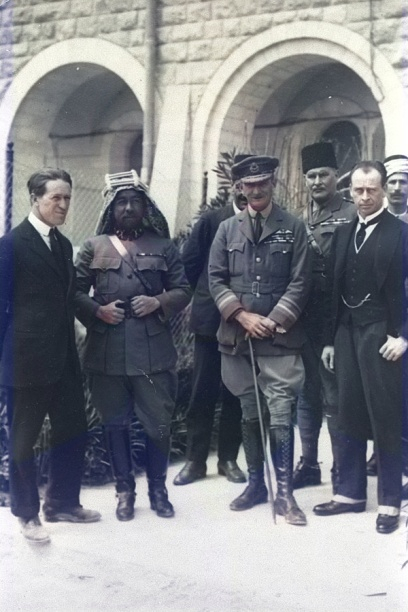In the intricate dance of wartime strategies during the Arab Revolt, the perspectives of key British commanders, notably General Murray and General Allenby, showcased a stark contrast in their understanding of the potential wielded by Sharif Hussein’s forces, guided by the enigmatic T.E. Lawrence. Here we delve into the British plan, examining the evolving perceptions of Arab involvement, the astute recognition by General Allenby of the Arab Revolt’s strategic value, and the instrumental role played by T.E. Lawrence in shaping and executing these plans.
General Murray’s Limited Vision
At the outset, General Murray held a restrained view of the Arab Revolt, deeming the Arab forces as little more than a “nuisance value.” Murray, the then-commander in chief in Egypt, perceived the Arab involvement as a means to tie down Turkish troops in Arabia. The Arabs, according to Murray’s initial assessment, were an untried and untrained force with limited potential for influencing the broader theatre of war.
General Allenby’s Strategic Insight
Contrary to Murray’s measured approach, General Allenby, who succeeded Murray in June 1917, exhibited a profound understanding of the Arab Revolt’s latent power. Allenby recognized that, under the charismatic leadership of Sharif Hussein and the tactical brilliance of T.E. Lawrence, the Arab forces could be more than a mere nuisance. Instead, they could serve as a dynamic force capable of disrupting Ottoman plans in a substantial way.
T.E. Lawrence’s Role in Success
T.E. Lawrence, often referred to as Lawrence of Arabia, emerged as the linchpin in the success of the Arab Revolt within British plans. His strategic brilliance lay in envisioning the Arab forces not as a passive entity but as a potent tool for disruption. Lawrence’s influence led to the Arab attacks on the Hejaz Railway, a masterstroke that not only tied down Ottoman forces but also yielded a substantial return on investment for Allenby.
Aqaba and the Turning Tide
The capture of Aqaba in July 1917 marked a turning point, with Allenby increasingly recognizing the significance of the Arab Northern Army, spearheaded by Prince Feisal and supported by Lawrence. The Arab forces stationed at Aqaba became a focal point in British planning, diverting the enemy, disrupting rail links crucial for Ottoman supply lines, and strategically harassing the Turkish left flank.
T.E. Lawrence’s astuteness in recognizing the true potential of the Arab Revolt, coupled with General Allenby’s strategic insight, reshaped British plans in the region. The Arab forces, once seen as a mere nuisance, became a dynamic and indispensable tool in the broader campaign for the Middle East. Lawrence’s legacy as a military tactician and strategist remains intertwined with the success of the Arab Revolt, highlighting the pivotal role played by this enigmatic figure in shaping the course of history.
Ambitious Aspirations & Strategic Setbacks of the Arab Revolt
In the tumultuous landscape of World War I, the Arab Revolt, led by the Hashemite leaders under Sharif Hussein, unfolded with grand aspirations to liberate Arabia from Ottoman rule. However, a confluence of challenges, including resource constraints, organisational hurdles, and tribal dynamics, tempered the realisation of these ambitions.
Liberation Aspirations and Inherent Challenges
At its core, the Arab Plan harboured a noble ambition — to rid Arabia of the oppressive grasp of the Ottoman Army and its administration. Yet, the stark reality was one of formidable challenges. The Hashemite leaders found themselves grappling with a dearth of resources, organisational deficiencies, and a tenuous support network among the tribes. These challenges, however, did not deter their initial zeal.
Spiritual and Strategic Objectives
The initial goals of the Arab Revolt were anchored in the spiritual and strategic significance of key locations. Mecca and Medina, revered as the holiest cities in Islam, stood as paramount objectives. Sharif Hussein, holding the title of Emir of Mecca, sought to convert spiritual influence into tangible political power. Additionally, the strategic importance of Ta’if, especially during the summer months, underscored the multifaceted nature of their objectives.
Geopolitical Chess: Hopes for Allied Support
The Hashemite leaders, cognizant of their limitations, harboured hopes of support from the Allied powers, particularly Britain and France. This geopolitical calculus manifested in shaping objectives beyond mere territorial gains. Red Sea coastal towns — Jiddah, Rabegh, and Yanbu — became focal points, not just for military advantage but as potential landing points for reinforcements and evacuation, underscoring the intricate geopolitical chessboard on which the Arab Revolt unfolded.
Strategic Ramifications of the Failure at Medina
The failure to capture Medina bore substantial strategic ramifications for the Arab forces. Internal rivalries emerged, exacerbated by the need to counter Turkish counterattacks. The Arab armies found themselves tethered to the vicinity of Medina and Mecca, contending not only with Turkish forces but also internal disputes. The inability to secure Medina necessitated a shift in priorities, with control of the Hejaz becoming a critical component of Hashemite planning.
In the midst of aspirations and challenges, T.E. Lawrence, a key figure in the Arab Revolt, played a pivotal role in navigating the complexities. His strategic acumen and the nuanced execution of plans significantly shaped the trajectory of the Arab Revolt, standing as a testament to the intricate interplay of historical forces during this pivotal period.
Prince Feisal’s Strategic Gains
Prince Feisal, a pivotal figure in the Arab Revolt, embarked on a strategic odyssey that transcended the borders of Arabia. His journey, intricately woven into the broader tapestry of the conflict, aligned with British plans and played a substantial role in shaping the course of history. Prince Feisal’s geopolitical foresight, the emergence of the Arab Northern Army as a potent force, and the catalytic capture of Aqaba prompted General Allenby to recognize and harness the formidable potential of these allied Arab forces.
Prince Feisal’s Strategic Vision
Prince Feisal, the third son of Sharif Hussein, emerged as a visionary leader whose ambitions extended far beyond the confines of Arabia. In a strategic pivot, Feisal looked northward, harbouring aspirations that transcended regional boundaries. Encouraged by the sagacious counsel of T.E. Lawrence, he sought to carve a role for himself in the geopolitical landscape of the broader Middle East.
Arab Northern Army’s Vital Role in British Plans
The Arab Northern Army, under the leadership of Prince Feisal, became a linchpin in British plans from the pivotal year of 1917. As Feisal strategically realigned with the interests of the British, the Arab Northern Army evolved into a dynamic force that would play a crucial role in the unfolding events of the war. Its significance lay not only in its military prowess but also in its potential to shape the geopolitical contours of the region.
Aqaba: The Catalyst for Recognition
The capture of Aqaba in 1917 marked a watershed moment in the Arab Revolt and solidified the strategic alliance between Prince Feisal’s forces and the British. General Allenby, astutely recognizing the potential of the Arab Northern Army, responded by sending military material to bolster their capabilities. Aqaba’s fall not only opened a new front in the conflict but also underscored the effectiveness of coordinated efforts between Arab and British forces.
In the broader panorama of World War I, Prince Feisal’s strategic decisions and the rise of the Arab Northern Army stand as testament to the intricate web of alliances and the evolving dynamics of the conflict. As Feisal looked beyond Arabia, aligning his aspirations with British plans, the Arab forces, under his leadership, became instrumental in shaping the trajectory of events in the tumultuous theatre of the Middle East.

The Sykes–Picot Agreement and the Betrayal of Arab Aspirations
Amidst the chaos of World War I, the political machinations of Britain and France unfolded in the form of the Sykes–Picot Agreement, a clandestine accord that laid bare the post-war plans for the Ottoman territories.
Division of Ottoman Territories
The Sykes–Picot Agreement, ratified in 1916, delineated spheres of influence and control over crucial regions. Syria, Lebanon, Turkish Cilicia, Mesopotamia, Transjordan, and Palestine were earmarked for British and French dominion. In a calculated move, Arabia was left with a semblance of independence, but the overall design contravened the fervent aspirations of the Arab populations.
Leaked Secrets: Fracturing the Allied–Arab Relationship
The clandestine nature of the Sykes–Picot Agreement meant that Arab leaders, including those leading the Arab Revolt, were kept in the dark about the true extent of the post-war arrangements. When the details of the agreement were leaked, a palpable sense of betrayal reverberated among the Arab ranks. The stark contrast between promises made and geopolitical realities strained the Allied–Arab relationship, introducing an element of distrust and disillusionment.
In the geopolitical chess game of the early 20th century, the Sykes–Picot Agreement stands as a testament to the complex interplay of imperial interests. The discord between the agreement’s provisions and the aspirations of the Arab peoples, coupled with its inadvertent exposure, reshaped the political landscape, leaving a lasting impact on the trajectory of the Arab Revolt and the broader dynamics of the post-war Middle East.
Ottoman Strategies
As the Ottoman Empire grappled with the convulsions of World War I, its designs on maintaining control over its Arabian territories were met with formidable challenges. The Ottoman Plan, marked by internal revolt and strategic countermeasures, unfolded against a backdrop of elusive tribal forces and pivotal geographical strongholds.
Ottoman Response to Arab Revolt
From 1916 onwards, the Ottoman Army found itself entangled in the intricate web of internal revolt within Arabia. Faced with the challenge of quelling the rebellious spirit of the Arab forces led by Sharif Hussein, the Ottoman authorities grappled with the need to regain control over the captured towns.
Countermoves and Challenges
The Ottoman countermoves, designed to suppress the Arab Revolt, were met with unexpected challenges. The vast and desolate expanses of southern Arabia proved to be a challenging terrain, with tribal forces exhibiting an elusive nature. The Ottoman Army found itself grappling with unconventional warfare, as the tribal enemy adeptly avoided direct confrontation, rendering traditional military tactics ineffective.
Strategic Focus on Medina
In the complex mosaic of Ottoman strategies, the city of Medina emerged as a strategic focal point. Beyond its religious and cultural significance, Medina served as a bastion for Ottoman control, keeping large Arab forces in check and serving as a base for planning decisive expeditions. The Ottoman high command recognized that as long as Medina remained under their control, the Arabian territories would remain contested but firmly within their grasp.
The Hejaz Railway: Lifeline for Ottoman Presence
Central to Ottoman designs in maintaining control was the Hejaz Railway. This vital infrastructure not only facilitated logistical support for the Ottoman Army but also served as a lifeline for sustaining their presence in Arabia. The railway’s importance extended beyond mere transportation, as it symbolised the ability to project military power and maintain a strategic foothold in the face of challenges.
In the labyrinth of Ottoman strategies, the Arab Revolt presented an unprecedented challenge, requiring adaptability and resilience from the Ottoman authorities. As internal turmoil unfolded and the elusive tribal forces continued to pose challenges, Medina and the Hejaz Railway emerged as linchpins in the Ottoman struggle to retain control over their Arabian territories amidst the tumult of World War I.

